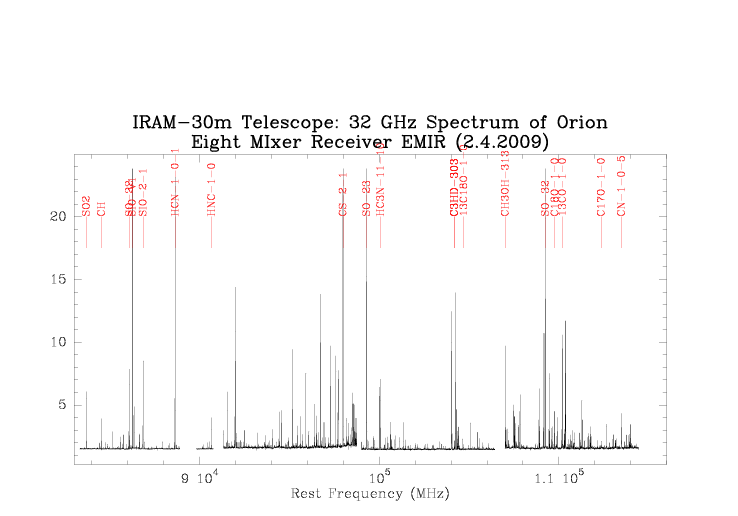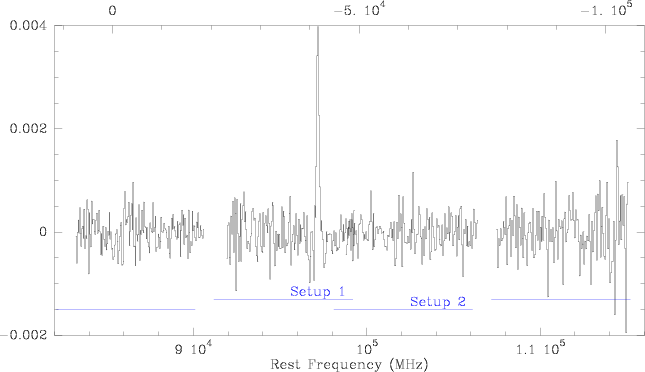|
Size: 3420
Comment:
|
Size: 1885
Comment:
|
| Deletions are marked like this. | Additions are marked like this. |
| Line 1: | Line 1: |
| /!\ under construction /!\ | #format wiki #language en #acl CarstenKramer:read,write,delete,revert,admin ClemensThum:read,write,delete KarlSchuster:read,write,delete |
| Line 3: | Line 5: |
| * by Juan Penalver, Hans Ungerechts, Helmut Wiesemeyer, Albrecht Sievers, Gabriel Paubert, Walter Brunswig, Clemens Thum, Carsten Kramer * and Melanie Krips, Sascha Trippe, Dirk Muders, Albert Greve, Karl Schuster * The following presentation is an excerpt from the report to the SAC: [[attachment:status30m-emir.pdf]] |
* E3 lower band tuning checked (260GHz). It was possible to tune it, but changing the harmonic mixer bias was needed. The Trx obtained were ~60-65K at LI band. Note that since this band was connected to synthesizer 2, the difficulty in tuning the line was not related with the problem of synthesizer 1 referred below. (3.5. GQ) |
| Line 7: | Line 7: |
| ==== Nasmyth Offsets ==== | The upper band edge of E3 still needs to be tested. All other band edges can be reached as announced in the call for proposal: * E0: 78-117, * E1: 130-174, * E2: 201-267, * E3: 260-? |
| Line 9: | Line 13: |
| The Nasmyth offsets were determined to be -39.0"/+5.5" for the left beam and +51.0"/+5.5" for the right beam. The left beam is used for most EMIR setups, i.e. for single band E0 or E2 observations, and for dual band E0/E2 and E0/E1 observations. The right beam is used for E1, E3, E1/E3. At present, the observer has to set the Nasmyth offsets in PaKo. They are not yet set automatically when switching the EMIR setup. | ==== Ripples and spurious signals ==== |
| Line 11: | Line 15: |
| to be written | |
| Line 12: | Line 17: |
| ==== Alignment ==== | ==== System Stability ==== |
| Line 14: | Line 19: |
| {{attachment:HminusV.png}} <<BR>> | to be written |
| Line 16: | Line 21: |
| The above figure shows the alignment between the four EMIR bands and between the two polarisations of each band. The overall alignment is better than 1 arcsec. | ==== Science verification ==== |
| Line 18: | Line 23: |
| ==== Foci ==== | * The following figure shows a spectrum of Orion IRc2 covering 32GHz of the 3mm window. It was taken with WILMA in wobbler switched mode in two EMIR setups in 30minutes of on+off observing time. Each EMIR setup used 16GHz simultaneously, both sidebands, with one polarisation. One broken WILMA unit was later repaired. The 4MHz/8GHz Filterbank was used in parallel, but data are not shown here. |
| Line 20: | Line 25: |
| {{attachment:fociHvsV.png}} | {{attachment:emir2a.png}} |
| Line 22: | Line 27: |
| The above figure shows the focus between different polarisations of the same band. There are no significant differences between these foci. | * A long 4 hour integration of the Cloverleaf, a quasar at high redshift, in the 3mm window, resulted in flat baselines with 0.4mK at 150km/s resolution. For this, we used WILMA in wobbler switching mode. The redshifted CO 3-2 line is confirmed. |
| Line 24: | Line 29: |
| {{attachment:fociBandBand.png}} | {{attachment:clover.png}} |
| Line 26: | Line 31: |
| This figure shows the focus between different bands. The largest deviation is about 0.3 mm, similar to the situation with the ABCD receivers. For dual band observations, the telescope should be focussed to the high frequency band. ==== Telescope Efficiencies ==== || '''Freq''' || '''HPBW''' || '''Feff''' || '''Beff''' || '''Aeff''' || '''S/TA*''' || '''Comments''' || || '''GHz''' || '''arcsec''' || '''%''' || '''%''' || '''%''' || '''Jy/K''' || || || 86 || 29 || 95 || 81 || 63 || 5.9 || || || 145 || 16 || 93 || 62 || 57 || 6.4 || || || 330 || 7 || 89 || 32 || 29 || 12.0 || || The main beam and aperture efficiencies, and the beam widths, were derived from Mars observations at about 43 deg Elevations, i.e. near the maximum of the gain elevation curve on March, 4th, 2009. ==== Continuum backends ==== At present, only the central 1GHz of each 4GHz chunk are being used for continuum detection. Broad band 4GHz wide continuum detectors are in preparation. ==== Spectrometers ==== During commissioning, we used the 4MHz filterbank and the two auto correlator backends WILMA and VESPA, partly in parallel. A variety of VESPA setups were checked, covering the range of resolutions between 3kHz and 1.25MHz and a wide range of bandwidths. VESPA parallel mode was also checked. However, it is not possible to check all possible setups. The 1MHz filterbank has not yet been commissioned. ==== Observing modes ==== The following switching modes were re-commissioned: position switching (onoff), wobbler switching, and frequency switching. Beam switching was checked using the continuum backends. The on-the-fly mapping mode was re-commissioned, in combination with position switching and with frequency switching. ==== EMIR setups ==== ==== Band Edges ==== ==== Commissioning observations ==== ==== To be done ==== |
=== Next steps === |
| Line 61: | Line 36: |
| * Band 4 will be fully commissioned later. | * Band 4 will be fully commissioned later and is in general not available this summer semester. |
- E3 lower band tuning checked (260GHz). It was possible to tune it, but changing the harmonic mixer bias was needed. The Trx obtained were ~60-65K at LI band. Note that since this band was connected to synthesizer 2, the difficulty in tuning the line was not related with the problem of synthesizer 1 referred below. (3.5. GQ)
The upper band edge of E3 still needs to be tested. All other band edges can be reached as announced in the call for proposal:
- E0: 78-117,
- E1: 130-174,
- E2: 201-267,
- E3: 260-?
Ripples and spurious signals
to be written
System Stability
to be written
Science verification
- The following figure shows a spectrum of Orion IRc2 covering 32GHz of the 3mm window. It was taken with WILMA in wobbler switched mode in two EMIR setups in 30minutes of on+off observing time. Each EMIR setup used 16GHz simultaneously, both sidebands, with one polarisation. One broken WILMA unit was later repaired. The 4MHz/8GHz Filterbank was used in parallel, but data are not shown here.

- A long 4 hour integration of the Cloverleaf, a quasar at high redshift, in the 3mm window, resulted in flat baselines with 0.4mK at 150km/s resolution. For this, we used WILMA in wobbler switching mode. The redshifted CO 3-2 line is confirmed.

Next steps
- The 1MHz filterbank is not yet available
- HERA needs to be tested before being available again
- Polarimetry will be commissioned later
- Band 4 will be fully commissioned later and is in general not available this summer semester.
A PaKo manual is in preparation. PaKo online help on new EMIR features is already available.
